Nicole Duffin (President’s Award)
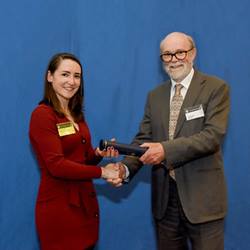 I am delighted to present the first President’s Award to Nicole Duffin of Shell.
I am delighted to present the first President’s Award to Nicole Duffin of Shell.
After graduating from Leeds University with a first-class degree in Geological Sciences, Nicole completed a Masters under a full Shell scholarship, for which she obtained a distinction and was awarded the University’s best overall performance prize.
Since joining Shell, Nicole has excelled, showing strong leadership capabilities and excellent technical expertise. She grasps opportunities to grow and makes a significant contribution to UK business.
Nicole is eager to share her passion for geology. She has a remarkable ability to communicate to any audience, on occasions turning to sandbox models and playdough to convey complex concepts!
A strong supporter of the Society, Nicole sits on the Science Committee and led the highly successful Janet Watson meeting in 2018.
Nicole Duffin, you combine expertise with creativity, innovation and infectious enthusiasm. You have all the attributes necessary to become a leader in the field. Please receive this President’s Award with our congratulations.
Oliver Dabson (President’s Award)
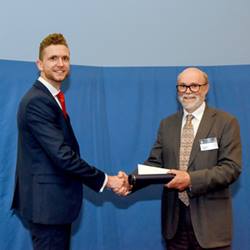 The second President’s Award goes to Oliver Dabson, an engineering geomorphologist with Jacobs.
The second President’s Award goes to Oliver Dabson, an engineering geomorphologist with Jacobs.
Ollie completed his undergraduate degree at Southampton University, followed by a Masters at the University of Sussex, for which he earned the distinction of highest-performing student.
At Jacobs, Ollie has shown a remarkable level of ability and confidence, supporting a breadth of clients on projects ranging from nuclear, to rail, oil & gas and highways.
With a strong commitment to the profession, Ollie is working towards chartership and has published numerous papers in core texts on submarine landslides and applied geological modelling.
Ollie has also undertaken impressive charity work for the Atlantic Whale Foundation and the Five Gyres Institute, and is an advocate for mental health awareness.
Ollie Dabson, you show huge aptitude in the field of Engineering Geomorphology and are an outstanding representative of the use of applied Geology in industry. You are a most worthy recipient of our second President’s Award.
We now come to the Funds of the Society. These are awarded to early career geoscientists who have made excellent contributions to geoscience research and its application, in the UK and internationally.
Dr Brendan McCormick Kilbride (William Smith Fund)
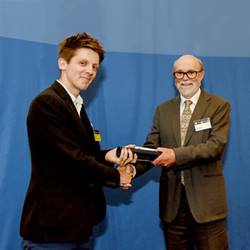 The William Smith Fund is awarded to Dr Brendan McCormick Kilbride of the University of Manchester.
The William Smith Fund is awarded to Dr Brendan McCormick Kilbride of the University of Manchester.
Brendan has developed an international reputation in volcanology. After his PhD at Cambridge, he won a prestigious Fellowship at the Smithsonian National Museum of Natural History in Washington DC. He held further postdoctoral positions in Cambridge and has recently begun a tenure-track Presidential Fellowship at Manchester.
Brendan’s research focusses on remote sensing and volcanic gas geochemistry. He has an impressive publication record. In particular, his work linking satellite-based observations of sulfur dioxide gas clouds with ground displacement around volcanoes has attracted significant interest.
Much of Brendan’s work has focussed on the remote and poorly monitored volcanoes of Papua New Guinea. Brendan has pioneered satellite-based methods to observe their gas emissions and has led major expeditions to PNG to collect gas samples from volcanic crater rims. He devotes significant time to interactions with local scientists, with the aim of building support networks and introducing them to new monitoring techniques.
Brendan has shown not only extraordinary academic promise, but also an ability to engage people, taking active roles in science festivals and acting as an adviser for a number of volcano documentaries.
Brendan McCormick Kilbride, please accept with our compliments the William Smith Fund of the Geological Society of London.
Dr Jonathan Pownall (Murchison Fund)
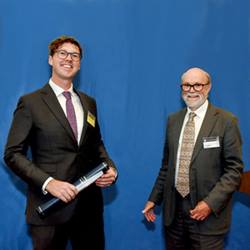 The Murchison Fund is awarded to Dr Jonathan Pownall of the Australian National University.
The Murchison Fund is awarded to Dr Jonathan Pownall of the Australian National University.
Jonathan has contributed to geoscience through excellence in the field. Working in the challenging and remote mountainous islands of eastern Indonesia, Jonathan discovered and dated ultrahigh-temperature metamorphic rocks and melts. He showed that these rocks, which are the youngest known example of ultrahigh-temperature metamorphism, formed during extreme extension and exhumation of the continental lithosphere, which was triggered by subduction rollback in the Banda arc. This process is rarely preserved in ancient orogens. Jonathan’s work thus provides new insights into the early stages of mountain building.
Jonathan also went on to show that a major young detachment fault could be traced on land in remote islands east of the Weber Deep that have only ever been visited by a handful of geoscientists. His work highlights the potential for major detachment faults to generate large earthquakes and tsunamis, in the Banda Sea region and more generally.
In recognition of Jonathan’s potential, he was awarded a Discovery Early Career Research Award Fellowship by the Australian Research Council.
Jonathan Pownall, we are delighted to award you the Murchison Fund of The Geological Society of London.
Dr Sam Giles (Lyell Fund)
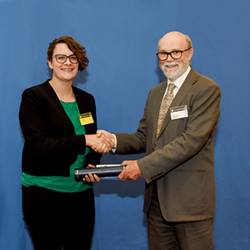 The Lyell Fund of the Society is awarded this year to Dr Sam Giles of the University of Birmingham.
The Lyell Fund of the Society is awarded this year to Dr Sam Giles of the University of Birmingham.
Sam is an outstanding palaeontologist working on the evolution of bony fishes, which are the ancestors of 99% of all living vertebrates. In recognition of her achievements, Sam was awarded a prestigious Royal Society Dorothy Hodgkin Research Fellowship, and two L’Oréal-UNESCO Women in Science awards, among others.
Sam completed her PhD research at the University of Oxford, working on the early origins of bony vertebrates and ray-finned fishes. Her subsequent research has explored key steps in vertebrate evolution, using state-of-the-art computed tomographic techniques to visualize and virtually dissect fossil data. Sam’s work on these previously neglected taxa led to her naming a number of new species and has called for major revisions to our understanding of the origins of some of the most important and species-rich vertebrate clades.
An active teacher, Sam has developed outreach activities for primary school children, including Palaeontology Explorer backpacks aimed at increasing the profile of women in palaeontology. Sam has also given a number of popular science lectures and written an invited submission for the Huffington Post.
Sam Giles, although only three years out of your PhD, you are already a leading international authority in your field. Please accept, with our congratulations, the Lyell Fund of The Geological Society of London.
Dr Andrew Parsons (Wollaston Fund)
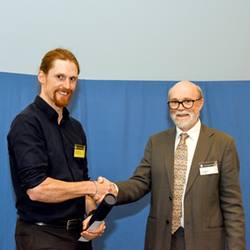 The Wollaston Fund is awarded this year to Dr Andrew Parsons of the University of Oxford.
The Wollaston Fund is awarded this year to Dr Andrew Parsons of the University of Oxford.
Andrew has a diverse and multi-disciplinary set of experience and skills. His research covers a wide range of subjects, from structural geology to metamorphic and igneous petrology, from plate tectonics to mantle rheology. He also uses a remarkably wide range of techniques, including field geology, optical and electron microscopy, whole-rock geochemistry and tectonic plate reconstruction modelling.
Currently, Andrew is using bedrock analyses, seismic tomography and plate tectonic reconstructions to investigate global palaeo-subduction zone dynamics and their influence on crustal processes and regional geology.
Andrew’s fieldwork has taken him to various tectonic settings in locations around the globe, including metamorphic terranes in the North American Cordillera and Himalayas, fold-and-thrust belts in the Spanish Pyrenees, arc settings in Yukon, strike-slip zones in the Himalayan Karakorum and passive margins in eastern Greenland. (Perhaps we should also be awarding him traveller of the year! I hope you are offsetting all your carbon too)
Andrew’s research output is exemplary. He has been awarded international prizes, including the 2017 Ramsay Medal from the Tectonic Studies Group, and continues to develop on a steep trajectory towards becoming a leader in geoscience research.
Andrew Parsons, in recognition of these achievements, we are delighted to award you the Society’s Wollaston Fund for 2019.
Before leaving the early career awards I would also like to mention the winner of the Society’s early career competition. This is organised by the Regional Groups, through a series of heats run locally followed by a final here at Burlington House, and was won this year by Jordan Lindsay, of the South West Regional Group (Cambourne School of Mines, University of Exeter).
I think you can see from the calibre of the young scientists we have seen today that the future of our science is in good hands, and I would ask you to join me once more in congratulating these young people and to wish them long and successful careers in geology.
Charmouth Heritage Coast Centre (R H Worth Award)
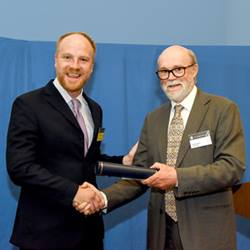 Moving on from the Funds, we come now to the R H Worth Award, which celebrates the practice and encouragement of geological science by and among amateurs. This year we are pleased to award it to the Charmouth Heritage Coast Centre.
Moving on from the Funds, we come now to the R H Worth Award, which celebrates the practice and encouragement of geological science by and among amateurs. This year we are pleased to award it to the Charmouth Heritage Coast Centre.
This charity, located on the Jurassic Coast of Dorset, brings geology to over 100,000 visitors each year. In addition to educating the public in the geology, palaeontology, geomorphology and natural history of the coast, the charity aims to encourage understanding of how these areas are managed and the heritage preserved.
The centre receives visitors from around the world and from all walks of life. It plays an important role in education, instructing over 4,000 school children annually. For many young visitors, the Charmouth Heritage Coast Centre provides their first contact with geology.
The Heritage Centre staff work with trained volunteers to organise ‘fossil walks’ that show off the geology of the coast and demonstrate how and where to find fossils. The centre’s volunteers have previously won the Queen’s Award for Voluntary Service.
2018 was an exciting year for the centre as it took a starring role two BBC documentaries. It was host to the 4-metre-long ichthyosaur that was the focus of the BBC documentary ‘Attenborough and the Sea Dragon’, presented by Sir David Attenborough, and also featured in the BBC 4 TV programme ‘Beach Live: Jurassic Coast Revealed’.
The centre plays an essential role in the discovery, collection and curation of materials found along an actively eroding coastline. It is a model for science internationally, enabling the discovery and preservation of finds, as well as the full engagement of the general public with the science.
And so, it gives me great pleasure to present this Society’s premier outreach award to Phil Davidson, who will accept on behalf of the Charmouth Heritage Coast Centre.
Phil Davidson replied:
President, Fellows, Ladies and Gentlemen, I am honoured to receive this award on behalf of the Charmouth Heritage Coast Centre. My name is Phil Davidson. I am the Senior Warden at the Centre and work with a small team of four staff. We are supported by over 85 dedicated volunteers from the local community.
The Heritage Centre is a small, independent charity that was set up by the local community in 1984 to help people understand the geology of our coast and to show visitors how to safely collect fossils and not become one in the process! Since then the Centre has grown organically and education is at the heart of what we do.
Our location on the seafront is perfect to engage with large numbers of visitors, and through our displays and guided events we help inspire people about the internationally important geology of our site.
All of the specimens that we display are loaned from local collectors and members of the public. Our most popular display is our ‘Recent Finds’ cabinet and I never tire of hearing the wonder and astonishment in our visitors’ voices when they discover that this amazing fossil was discovered only a few months ago by an 8-year-old, first-time fossil hunter!
Anyone can make a discovery at Charmouth and we record scientifically important specimens for a voluntary Fossil Collecting Code. Many of these finds contribute to publications and add to our understanding of the Jurassic of Dorset.
I am here to collect this award on behalf of our charity’s staff, volunteers, trustees and patrons, past and present. The Charmouth Heritage Coast Centre is very special place and is many people’s first introduction to geology and we hope to continue to inspire future generations of geologists. Thank you.
Mr Colin Day (Distinguished Service Award)
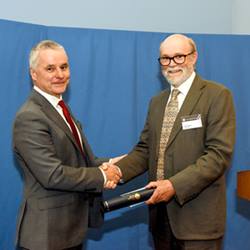 We now come to the Distinguished Service Award, which recognises the contributions of an individual by virtue of their professional, administrative, organisational or promotional activities. This year, the award goes to Colin Day of the NERC National Marine Facility, at the National Oceanography Centre.
We now come to the Distinguished Service Award, which recognises the contributions of an individual by virtue of their professional, administrative, organisational or promotional activities. This year, the award goes to Colin Day of the NERC National Marine Facility, at the National Oceanography Centre.
Over the last 25 years, NERC’s National Marine Facility has delivered in excess of 1000 scientific research cruises, across a range of disciplines as diverse as atmospheric physics and chemistry, bird migration, the marine food chain, ocean acidification, water circulation and ice dynamics, not to mention seabed and sub-seabed sampling and imaging, from the surface to the deepest mantle. These research cruises underpin the UK’s position at the forefront of excellence in marine research.
Typically, those that do science get the accolades; those that underpin the ability to do excellent science do not. But they are no less worthy.
For 15 years, Colin has end-to-end planned and scheduled every scientific cruise utilising the national research vessels, regardless of discipline. This is no trivial task, requiring a delicate balance between diplomacy, scientific understanding and technical capabilities.
Among other things, Colin has chaired the Ocean Facilities Exchange Group, which ensures collaboration between European nation’s research vessels; he designed the Ship time and Marine Planning online Portal through which all UK-funded researched cruises are managed; and he sits on a variety of advisory boards, including assisting with the at-sea fitness-for-science trials of the RRS Sir David Attenborough (aka Boaty McBoatface) and the European Marine Board working group for future research vessel operations.
Colin’s extensive experience and breadth of knowledge have resulted in countless successful at-sea operations that have placed UK marine research at the leading global edge.
In honour of your work and dedication to the NERC National Marine Facility, Colin Day, please accept the Distinguished Service Award of the Geological Society of London.
Colin Day replied:
First of all, thank you for that very flattering review, and it’s an honour to be nominated for this award.
As mentioned by the previous speaker, I have been working for the Natural Environment Research Council for the best part of 30 years in a number of roles with many years spent working at sea.
The science community I have worked alongside for many years operate in a highly collaborative environment…. even though, as we are all aware, there is serious competition between individual scientists…
Much like the scientific community, the operational and technical support services we provide to the scientific community also operate as a highly collaborative, integrated group of people; and it’s only due to being a part of this broad supported environment that I have been able to provide the support to the marine science community over many years.
I am a mining engineer by background, and came to work in the area of marine science support by joining the Research Vessel Services (RVS) in Barry, South Wales where they operated the NERC research ships out of Barry docks… From that point 30 years ago I have had the privilege of working with many dedicated sea-going technicians, engineers, marine and shore support staff who were, and still are, essential to the successful delivery of the excellent science many of the people in this room are responsible for delivering.
So, some decades on, the NERC research ships are operated out of the National Oceanography Centre in Southampton, RVS is now NMF, those young engineers are either grey haired like me, or retired, but the tradition of delivering excellent technical and operational support to the UK marine science communities continues.
I am proud to be nominated for this award, but proud to receive this award on behalf of the many dedicated technical and operational staff who work across the research councils, universities, colleges and institutes, who are responsible for maintaining and supporting the infrastructure and resources that enable the UK science community to continue to lead the world in many areas of scientific endeavour.
Thank you!
Dr Andrea Cozzi (Aberconway Medal)
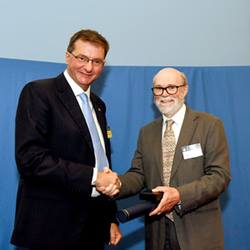 We come now to the Aberconway Medal, which recognises distinction in the practice of applied or economic geoscience. This year the medal is awarded to Dr Andrea Cozzi of Eni (The Italian State Oil Company) Upstream & Technical Services.
We come now to the Aberconway Medal, which recognises distinction in the practice of applied or economic geoscience. This year the medal is awarded to Dr Andrea Cozzi of Eni (The Italian State Oil Company) Upstream & Technical Services.
Andrea, a leading industry geologist, is an expert in carbonate sedimentology, hydrocarbon exploration risk assessment and Precambrian petroleum systems.
Andrea started out in academia, studying the carbonate platforms of the Carnian Pre-Alps in northern Italy during his PhD research at Johns Hopkins University in Baltimore. He went on to take up a post-doctoral position at Trinity College Dublin, followed by a lectureship at ETH Zurich. Andrea published ground-breaking research on carbonate systems in Italy and Neoproterozoic successions in Oman.
In 2001, Andrea started to make the transition into industry, working first as a Carbonate Geologist with Petroleum Development Oman, before moving to the Regional Environment Protection Agency in Udine, Italy, as a Technical Scientific Collaborator. During this time, Andrea carried out environmental impact assessments for quarries, waste-disposal sites and hillslope hazard mitigation, providing him with a critical awareness of the environmental impacts of industrial operations.
In 2006, Andrea joined Eni. He quickly climbed the ranks from Carbonate Geologist to Exploration Technical Leader, Project and Exploration Manager, and Vice President of Exploration. An outstanding exploration manager, Andrea led the Eni team that was responsible for the identification and later discovery of the super-giant Zohr Gas Field offshore Egypt, in 2015. This was one of the largest gas discoveries in the world. It helped rejuvenate Egypt’s economy and opened a previously unrecognised gas play in the Eastern Mediterranean region.
Andrea Cozzi, please accept with our compliments the Aberconway Medal of the Geological Society.
Andrea Cozzi replied:
Thank you, Mr. President, and thanks to the Awards Committee, Council and nominators for this award. I feel most honoured and humbled to accept the Aberconway Medal. It was indeed a wonderful surprise, a recognition that made me look back into my life as a geologist and identify the key ingredients that brought me here today to receive this award.
First of all, being born at the foothills of the Alps of northern Italy where more than 90% of rocks cropping out are shallow water carbonates of some sort, was a clear career path that I followed from my early days at University of Trieste, where I learned how to do field mapping with Professor Gianbattista Carulli and Maurizio Ponton, my undergraduate mentors.
To become a real carbonate sedimentologist, though, I crossed the Atlantic where I was fortunate enough to be one of the last PhD students of Lawrence Hardie at Johns Hopkins, from whom I learned to put in doubt the scientific status quo and not to be afraid of believing in my ideas and bringing them forward. Lawrie forged my mind as a scientist and I know that I would not be here today if I had not worked with him! With Philip Allen, first at Trinity College and subsequently at ETH Zurich, my slow transition into the petroleum industry had started and Philip helped me along the way by sharing his vast knowledge in both realms and providing constant advice.
Once I joined Eni, many colleagues helped me quickly acquire hydrocarbon exploration skills and get an appetite for new business opportunities in the petroleum basins around the world. I would like to thank my first office mate in Milan, Alessandro Barberis, my exploration managers, Lorenzo Meciani, Andrea Degli Alessandrini and Giacomo Spadini, who exposed me to increasing responsibility, allowing me to flourish in the company in my early days. Jonathan Craig always believed in me, since we first met on my interview day 14 years ago, Luca Bertelli gave me the opportunities to prove myself during these years at Eni. Thanks to both of you.
But, if I think about a project in Eni that I was involved with and that really stands out, it is the discovery of the Zohr Giant Gas Field in 2015, an amazing story that started with my exploration team in Egypt in 2012. We were scientific in the data analysis, yet inventive and brave to search for carbonates for the first time after 50 years of clastic Nile Delta Exploration. The identification of the Zohr play, to me, is the demonstration that rigorous scientific knowledge and the human factor can still make the difference in our business, which is increasingly dominated by technology. This award is therefore also for you my dear Zohr New Venture team: Hamed Harby, Paola Ronchi, Juan di Croce, Matteo Minervini, Antonio Cascone and for all my Eni colleagues that worked on the Zohr project!
On a personal note, I think that my attitude towards exploration of our amazing Planet Earth started with my parents and family. Whether it was hiking in the Alps or exploring the beauties of Italy together in my childhood days, that respect for nature and quest for knowledge that I have inside me today started back then because of you.
To conclude, I would never stop thanking my wife Giuseppina, my son Stefano and daughter Elena for their constant love and support. This medal only partly compensates all the time together we missed while being often apart during these last 20+ years of work abroad or doing field campaigns in the mountains and deserts. Those years will not come back, but I am sure you see now that sacrifice and hard work always pay off at the end. Thank you all!
Professor Emily Rayfield (Bigsby Medal)
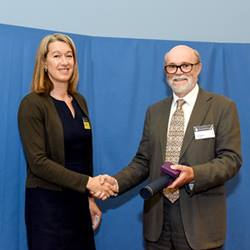 Next is the Bigsby Medal, which this year is awarded to Professor Emily Rayfield of the University of Bristol.
Next is the Bigsby Medal, which this year is awarded to Professor Emily Rayfield of the University of Bristol.
Emily is a world-leading palaeontologist who investigates skeletal mechanics and evolution. Looking at both living and extinct animals, Emily uses various methods to determine how skeletons function and to explore how this function has evolved, for example, in response to major environmental change. In particular, Emily looks at the evolution of the skull and its relation to feeding behaviour in dinosaurs, birds, crocodiles and mammals, principally during the land-to-water transition.
Emily has also been involved in projects that explore the function of hard tissues in marine creatures, such as sponges, coralline algae, foraminifera, bivalves and scaphopods, with the aim of understanding the resilience of the skeleton in acidifying oceans. (No, I’d never heard of scaphopods either, apparently, they are tooth shells.)
Emily’s major novel contribution is the development of the technique of finite element modelling to understand the mechanics of animal skeletons. This innovative research has been especially influential in illuminating morphological changes across major evolutionary transitions, such as the origin of birds and mammals. Emily’s work has revitalised research on the feeding and behaviour of extinct animals, helping to shift assertions rooted in just-so stories into scientific hypotheses that are tested quantitatively with computational methods.
Emily has served as Vice President of both the Palaeontological Association and the Society of Vertebrate Paleontology, and she is currently President of the Society of Vertebrate Paleontology.
Emily Rayfield, your novel and creative approach has led the transformation of palaeontological functional morphology into a scientific discipline. We have no doubt that you will continue to make seminal contributions to our understanding of the palaeobiology of ancient organisms at major evolutionary transitions. Please therefore accept today, with our congratulations and confidence in your successful future, the Bigsby Medal of The Geological Society of London.
Emily Rayfield replied:
Mr President, fellows of the Society, first and foremost I'd like to say what a special honour
it is to be awarded the Geological Society’s Bigsby Medal in recognition of my contributions to the wider Earth Sciences research. I would like to sincerely thank those who nominated me for the medal.
I came to geology, and especially palaeontology, via a narrowing of a broad range of interests centred around the historical and the natural world. I thank my parents for their unwavering support to pursue my varied interests, and my wider family, especially my aunt and uncle who were school teachers at the time, for taking my brother and I round numerous museums under the pretence of practising their school topic worksheets on us.
A-level Biology, taught by Mr Chew (perhaps a premonition of my interest in feeding mechanics), furthered my interest in biology led to me applying to and being accepted to study Biological Sciences at Hertford College Oxford. My final year dissertation supervisor Andy Purvis further fuelled my interest in evolutionary biology and Tom Kemp’s lectures in Vertebrate Evolution were not so much a penny drop moment, but a growing realisation that palaeontology brought together my so far disparate interests in anatomy, evolution and the study of past life.
After a year spent growing human skin tissue in a plastic surgery research lab at UCL, I decided on applying for a PhD. Serendipitously, part of my research involved studying how fibroblasts, skin cells, respond to applied load. A PhD project with David Norman at the University of Cambridge studying how dinosaur skulls respond to applied loads, this could not have been a better fit. The PhD involved developing the engineering method finite element analysis for the study of fossil bones, a challenging prospect for long-dead animals with petrified bones, but ultimately, eventually, I succeeded, and the application of engineering and biomechanical methods to understand organismal form, function and evolution has been core to my research ever since.
Flipping back to a short postdoc in Oxford, then to a Junior Research Fellowship in Cambridge, then to a postdoc at the Natural History Museum London, I moved to Bristol in 2005, where I’ve been ever since. I thank my colleagues and the students and postdocs in Bristol for providing a stimulating and supportive environment.
I wish to thank my husband Rob, who together we have navigated the challenges of the two-body career problem and raising our wonderful children, George and Harry. And finally, it would be remiss of me in this venue not to mention my maternal great-great-great grandmother, Mary Sedgwick of Dent, related, who perhaps via some distant relatedness has provided my much-diluted genome with a certain propensity for the study of geological science.
Professor Bramley Murton (Coke Medal)
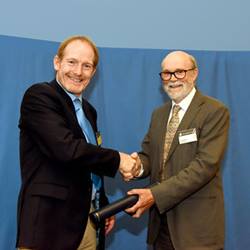 We now come to the Society’s two Coke medals, awarded to geoscientists who have made a significant scientific contribution and been of notable service to geology through activities of benefit to the community.
We now come to the Society’s two Coke medals, awarded to geoscientists who have made a significant scientific contribution and been of notable service to geology through activities of benefit to the community.
The first goes to Professor Bramley Murton of the National Oceanography Centre.
Bram is an outstanding marine geologist with 30 years of experience as Chief-Scientist-at-Sea investigating the construction of oceanic crust and its interaction with the ocean. He started his geological career as a PhD student under the guidance of Professor Ian Gass at the Open University. Later, with a Royal Society Fellowship grant, he undertook an extensive mapping-based study of the Troodos Ophiolite in Cyprus. After joining the Institute of Oceanographic Sciences Deacon Laboratory, Bram took his mapping skills to the modern-day seafloor, pioneering the innovative use of sonar-based remote sensing.
In 1997, Bram moved to the National Oceanography Centre in Southampton where he progressed the art of seafloor mapping with new technologies, including autonomous underwater vehicles. A field geologist at heart, Bram developed the HyBIS robotic vehicle to act as his eyes and hands on the deep seafloor. This device led to the discovery of the deepest-known hydrothermal vents, the Beebe Vent Field at 5 km depth in the Mid-Cayman Spreading Centre, as well as a new class of hydrothermal system on the ultramafic massif ‘Mount Dent’.
Bram has made a sustained academic contribution and has led technical innovations in the field, driving the development and commercialisation of seafloor vehicles.
Bram has shown remarkable leadership. He was previously head of InterRidge, an international non-profit organization concerned with promoting all aspects of mid-ocean ridge research. During his tenure, he instigated a programme for young scientists to gain invaluable experience by joining research cruises.
Currently, Bram directs UK strategic efforts to investigate the potential for the environmentally sustainable exploitation of seafloor mineral deposits that are critical for low-carbon technologies. He currently leads a NERC-funded research programmes on hydrothermal mineralisation and cobalt-rich crusts in the Atlantic Ocean.
Bram is recognised as the go-to UK scientific expert to whom politicians, media and industry experts from the emerging deep-sea mining sector turn when engaging with the scientific community. Bramley Murton, the breadth and depth of your service to geoscience and the community render you a most worthy recipient of the Coke Medal of The Geological Society of London.
Bramley Murton replied:
Mr President, ladies and gentlemen of the Awards Committee, Council and nominators for this award; thank you!
I am deeply honoured and pleasantly surprised by the nomination for a Coke Medal, which I am delighted to accept. In doing so, I am accepting the medal on behalf of all those people that have encouraged, inspired and supported me on my way, not least my wife Alizon and my long-suffering family.
My journey to this point has been one of wonderful surprises, made possible by exceptional people that have nurtured my early fascination with our planet, and encouraged me to build a career as a geologist. There are many, and I can’t mention them all, but here are some that had a particular influence.
As a young lad growing up in the west of Scotland I was privileged to be taken on a gold-panning trip by the famous Antarctic explorer, Sir Vivian Fuches. My curiosity was sparked by his tales of exploration, not just of the South Pole, but through the aeons of time represented by the mountains and rocks that surrounded us.
As an undergraduate at Edinburgh University, I owe a debt of gratitude to Dr Roy Gill who, in my first year explained to me that “a rock is a book, and all you have to do is learn to read it.”
I am also greatly indebted to Prof Ian Gass. As a young PhD student at the Open University, Ian was a real inspiration. Sometimes cantankerous, always challenging, Ian taught me to think of the ‘big picture’, think laterally, question everything, and always make careful observations.
My love of geology was invested in my love of the mountains, so after my PhD on the Troodos ophiolite in Cyprus, I surprised myself when I became fascinated by the geology of the deep ocean floor. For this, I thank Dr Lindsay Parson, who invited me on a cruise of the RRS Charles Darwin to explore the West Pacific, and introduced me the wonderful world of marine geoscience. The rest is history and, for that, I thank you all.
Professor Richard Law (Coke Medal)
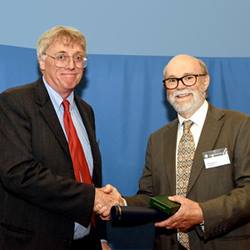 The second of the Society’s Coke medals is awarded to Professor Richard Law of Virginia Tech.
The second of the Society’s Coke medals is awarded to Professor Richard Law of Virginia Tech.
Rick began his research career studying for a doctorate in structural geology at the University of London, under the supervision of Tony Barber. He went on to carry out post-doctoral research at the University of Leeds, working with Professors Mike Coward and Rob Knipe. In the late 1980s, we lost Rick to the US—he took up a professorial post at Virginia Tech and has stayed there ever since.
Rick is now an international leader in the study of deformation mechanisms in geological materials. In particular, he looks at geologic relationships between the micron and mountain scales, using preferred orientation patterns in quartz, as well as deformation thermometry, to infer links between strain and the formation of geological structures.
Over the years, Rick has contributed greatly to our understanding of thrust-belt tectonics, and pluton-emplacement mechanisms. Rick has unravelled tectonics and faulting in the Sierras Pampeanas region of western Argentina, characterized extensional deformation in the Brooks Range of northern Alaska, worked on emplacement mechanisms of Jurassic and Cretaceous plutons in the White-Inyo Mountains of eastern California, investigated links between Miocene basin formation and strike slip motion on the San Andreas fault system in southern California, described the tectonic evolution of the High Himalaya in the Mount Everest, Annapurna and Sutlej river valley areas, and provided insight into the structural and tectonic evolution of the Caledonides of Northwest Scotland. The quality of Rick’s work is borne out by an impressive publication and citation record.
In addition to his contributions to geology, Rick’s service to both the Society and the Geological Society of America over the past 18 years is exceptional. He has co-convened or co-led 22 conferences or field excursions for the benefit of the community, has served in various publication roles, including the Geological Society of America Bulletin and Journal of the Geological Society, and is currently Chair and Editor-in-Chief for the Society’s Books Editorial Committee.
Richard Law, you exemplify the very spirit of the Coke Medal of the Geological Society of London and we award it to you now with great pleasure.
Richard Law replied:
Mr. President, thank you for your kind words. My research career has focused on using microstructures and crystal fabrics to study the evolution of geologic structures at scales ranging from the thin section to the mountain belt, and puts me somewhere between field-based structural geologists and the experimental rock deformation community, perhaps resulting in my not quite belonging to either traditional group.
I was lucky in receiving a broad geologic training as an undergraduate at Kingston Polytechnic, where first priority was always on student teaching and fieldwork. I am particularly delighted to be the fourth Kingston student to receive the Coke Medal, following Robert Thomas, Richard Selley and Robert Kidd who were awarded Coke Medals in 2013, 2010 and 1996.
After Kingston, the MSc course in structural geology at Imperial College opened my eyes to a whole new way of thinking about the evolution of geologic structures, employing basic principals in materials science and rock mechanics. A PhD at Chelsea College on western Brittany with Tony Barber, who is this year’s Prestwich medalist, followed by a postdoc at Leeds with Mike Coward and Rob Knipe on the Moine thrust zone, gave me the academic freedom to explore potential new research projects and begin putting these principals in to practice.
Moving to Virginia Tech in 1987 gave me the opportunity to work in a wide range of geologic settings in North America. I am particularly grateful to John Christie, Clem Nelson and Gerhard Oertel at UCLA, Rick Sibson and Art Sylvester at UC Santa Barbara, and Elizabeth Miller at Stanford, for introducing me to some wonderful field areas in Alaska and particularly California, that became the focus for my students’ research projects over the next 15 years. I would also like to thank Peter Treloar at Kingston, and Mike Searle and Dave Waters at Oxford, for generously inviting me to work with them in the Himalaya. Over the last 20 years this has led to some memorable adventures in the ‘high places’ with both Mike and our research students, including the recipient of this year’s Wollaston Fund, Andy Parsons.
Mr. President, I thank you and those who nominated me for this honour.
Dr Nigel Woodcock (Dewey Medal)
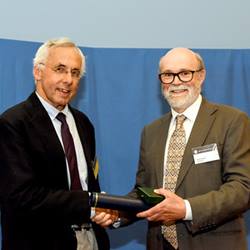 The Dewey Medal, made possible by a generous endowment from Professor John Dewey, is a lifetime achievement award. It is given to a geologist who has championed the use of classical geological mapping or field observations, and who has a strong record of training, leading and encouraging others to practise and pursue advances in geology by these means.
The Dewey Medal, made possible by a generous endowment from Professor John Dewey, is a lifetime achievement award. It is given to a geologist who has championed the use of classical geological mapping or field observations, and who has a strong record of training, leading and encouraging others to practise and pursue advances in geology by these means.
This year, the Dewey Medal is awarded to Dr Nigel Woodcock of the University of Cambridge.
For over 40 years, Nigel has researched and taught at the interface between structural geology, tectonics, sedimentology and stratigraphy, building on methodical and exhaustive fieldwork.
He completed his PhD in 1973, under the direction of John Ramsay, using structural methods and examples in the Welsh Basin to understand slump systems. This early work established two themes for his research career: soft-sediment deformation and integrative regional tectonic geology.
Nigel’s field-based research placed him at the forefront of new ideas in linked fault systems, strike-slip regimes, strain-pattern quantification, faulting patterns in porous rocks and the deposition of juxtaposed turbidites.
His work has been central in deciphering the Tethyan history of the eastern Mediterranean and the Palaeozoic evolution of England and Wales. Indeed, his careful mapping, together with structural and sedimentological fieldwork, has been synthesised into current understanding of the tectonic evolution of Britain, south of the Iapetus Suture, it underpins over 150 square kilometres of BGS mapping, and contributes to the Geological Conservation Review.
Nigel is a strong defender of geological fieldwork training within Cambridge, the Geological Society, and in academia at large. Through his teaching, Nigel has inspired generations of students to follow careers in research. He has brought a love of fieldwork to cohorts of students, motivating them to approach field geology with methodological, careful observation, even when working on rain-swept Cumbrian fells.
So, for your fundamental contributions to understanding the geological history of Britain, your pioneering work on fault rocks, faulting processes and soft-sediment deformation, and for your inspirational teaching, Nigel Woodcock it is our great pleasure to present to you the Dewey Medal of The Geological Society of London.
Nigel Woodcock replied:
Thank you, Mr President, for those generous words.
For me, geological field work has always been a pleasure and a reward in itself, and so I feel rather embarrassed to be honoured for it. However, the award is partly to recognise the importance of field geology more generally. I share with John Dewey and the short list of previous recipients of his medal—Rob Butler—their strong belief in the enduring value of field work for geological research and teaching. They have also both been role models for me in how to represent pictorially the complex four-dimensional geometric and genetic relationships of deformed rocks.
It was boyhood rock and fossil collecting on the western fringes of Sheffield that first got me interested in geology. I was initially taught how to make geological maps by Jack Treagus at Manchester and John Ramsay at Imperial College. But fieldwork skills are learned incrementally through a career. Research work in the Tethyan Belt with Alan Smith and Alastair Robertson was formative. So was half a lifetime of research on the Lower Palaeozoic rocks of England and Wales with clever graduate and undergraduate students. More recently, Jack Soper was an influential collaborator in contract mapping for the Geological Survey in Cumbria.
I have spent almost as much time teaching in the field as I have doing research. I taught, in turn, on all the field courses run from the Cambridge department, but the highlight for me was the chance to develop the Cambridge mapping course in Cumbria with Barrie Rickards. Over more than 40 years, we taught about 1,500 students the skills and art of geological mapping and field research. Few things in my geological life have been more rewarding.
Fieldwork is sometimes wrongly portrayed as all about observation and data collection. As Rob Butler emphasised last year, fieldwork is even more about geological interpretation. The outdoors stimulates scientific speculation and debate, and the iterative hypothesis testing of fieldwork is one of its joys. Add in the often spectacular places that we visit and the close personal relationships we make, and the addictive nature of fieldwork is explained.
Thank you to all the colleagues and students who have enriched my geological field career, and to the Society for recognizing the results today.
Dr Anthony Barber (Prestwich Medal)
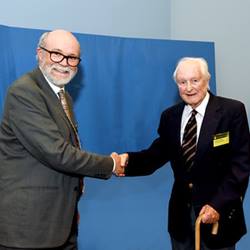 The medal named for Joseph Prestwich goes to Dr Anthony Barber, Emeritus Reader in Geology at Royal Holloway, University of London.
The medal named for Joseph Prestwich goes to Dr Anthony Barber, Emeritus Reader in Geology at Royal Holloway, University of London.
Tony’s research interests include the regional geology, structure and tectonics of Northwest Scotland, Leinster and Anglesey. He is also an acknowledged authority on the geology of Southeast Asia, having served as Director of the University of London’s SE Asia Geological Research Group for twelve years. On behalf of the Geological Society, he has edited, and contributed to, major works on the geology of SE Asia.
As a university lecturer for over 35 years, Tony ran numerous international short courses, lecture series, practical classes and fieldtrips on all aspects of geology, at home and abroad. He tutored numerous graduate and post-graduate students from Britain and overseas.
Although based at London University for the whole of his working life, Tony’s research and consultancy work has taken him around the globe. He has worked as a Research Fellow at the Geological Survey of Japan and the Australian National University, and as a consultant to the United Nations, Studies in East Asian Tectonics and Resources (SEATAR) Program, based in Bangkok, to the Indonesian Research and Development Centre in Bandung, and to the British Antarctic Survey for Research Programmes in West Antarctica.
What sets Tony apart, is his commitment to the geological community. He has served as a council member for both the Geological Society of London and the Geologists’ Association, receiving the GA’s Foulerton Award in 2014, in recognition of his outstanding support for the Association. He has served on numerous committees, including NERC’s Deep Drilling Initiative and Awards Committee, and the Royal Society’s Earth Resources Committee.
Tony’s editorial service includes editorships of the Proceedings of the Geologist’s Association, the Journal of Structural Geology, as well as the Journal of Asian Earth Sciences. Although now retired, Tony continues to review.
Tony Barber, you have devoted your life to serving the geological community, both in the UK and internationally. You have enabled the geological achievements of numerous others, through your teaching and research, and through your committee and editorial services. It gives me great pleasure to present to you the Prestwich Medal.
Tony Barber replied:
I thank the President and Council of the Society for this Award. It is gratifying, to receive recognition by the geological profession that I have done a good job.
During a long career, I owe a debt of gratitude to all who assisted and encouraged me along the way.
Dr W.F.Fleet, employed me as Laboratory Assistant, at Chelsea Polytechnic, permitted me to study for a degree in Geology.
Prof John Sutton supervised my Ph.D. studies. and recommended me for the editorship of the Proceedings of the PGA. Dr W.E. Smith, appointed me Assistant Lecturer, at Chelsea College, with responsibility for a lecture course in Physical Geology, at the time when the building blocks of Plate Tectonics were being put in place. Mike Audley-Charles, invited me to Timor, a region of active tectonics. Successive Directors of the Indonesian Research and Development Centre, Bandung, and Lemigas, Jakarta, supported British and Indonesian research students throughout Indonesia. Leaders of BGS Missions to Indonesia, Barry Page, John Hepworth and Sandy Macfarlane, arranged logistical support for British students and funding, through the British Council, for Indonesian students in the U.K.
BGS recommended me as consultant to the UN Studies in East Asian Tectonics and Resources (SEATAR) programme, to prepare, together with Derk Jongsma, a review of the geology and tectonics of the island arc systems of east and southeast Asia, leading to invitations to participate in marine geophysical cruises in the Banda Arc, with Carl Bowen (Woods Hole), Dan Karig and Eli Silver (Hawaiian Institute of Geophysics), Indonesian-Dutch Snellius II Expedition, with Derk Jongsma, GRDC Expedition to islands of the eastern Banda Arc with H.M.S Hartono and US National Science Foundation Expedition to Tierra del Fuego and Antarctica with Ian Dalziel.
Visits to Indonesia were initially funded by the British Council, NERC and the University of London Research Fund, until Prof Derek Blundell put together a Consortium of Oil companies to support the work in southeast Asia, ably continued by Robert Hall.
I also owe a debt to my research students in Scotland, Brittany and southeast Asia, and to Mike Crow and Mike Ridd for support and encouragement over the last twenty years.
Professor Frances Wall (William Smith Medal)
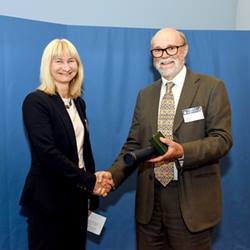 The William Smith Medal celebrates outstanding achievement in the field of applied geology. This year we are delighted to present it to Professor Frances Wall of the Camborne School of Mines, at the University of Exeter.
The William Smith Medal celebrates outstanding achievement in the field of applied geology. This year we are delighted to present it to Professor Frances Wall of the Camborne School of Mines, at the University of Exeter.
One of the major issues in economic geoscience today is the security of supply of raw materials that are widely used in new technology, but that have restricted sources. These are the so-called critical metals and include the rare earth elements. Frances works at the forefront of research to diversify the supply of these materials.
Indeed, Frances is a trailblazer in this field. She developed this research at a time when most geoscientists were unaware of the importance of the rare Earths, viewing them simply a useful petrogenetic tool. Over the past 25 years, she has accelerated understanding of the ore deposits of critical metals associated with alkaline and carbonatite rocks. Her extensive research experience and publication record mean that she is now widely viewed as the UK’s main expert in this field.
Frances has a remarkable ability to encourage people to work together. She successfully secured funding for and leads two major international research consortia—the NERC-funded SoS RARE and the EU-funded HiTech AlkCarb—which investigate the geology and metallurgy of the rare Earth elements and other critical metals. She also drives research on responsible mining, through various projects that look at the environmental and social impacts of mining-related activities, and the sustainable supply of raw materials in Europe.
Frances is President of the Cornish Institute of Engineers, she was the first female President of the Mineralogical Society and was voted as one of the “100 Global Inspirational Women in Mining, 2016”. Whilst Head of the Camborne School of Mines, Frances positioned the department as an international centre for research into critical metals and responsible mining. She also set up the Critical Metals Alliance with the British Geological Survey and is a leading light in the renaissance of Cornwall as a mining area.
Frances Wall you are one of our nation’s leading economic geologists, carrying out research that is vitally important for modern technology. It is my great pleasure to award you the William Smith Medal of The Geological Society of London.
Frances Wall replied:
President and members of The Geological Society, thank you and the Geological Society for such a high honour as a medal named after William Smith. When I saw the email arrive, I just assumed it was a request to nominate someone else and it was such a nice surprise, I even had to get a friend to read it to make sure it was correct.
On looking up previous acceptance speeches, I found last year’s clever one by Peter Dolan relating his career to oil formation. For minerals, I might start with some small degree partial melting, of careers choices. I was interested in a career that was a bit different, something I liked and not too much to do with people—so I chose rocks(!)—and geochemistry at Queen Mary College London. I then joined the Natural History Museum in London, and picked research on carbonatites and their delightful rare earth minerals, more for fun rather than foresight. Bob Symes, Paul Henderson, Alan Woolley, Terry Williams, Mike Le Bas from Leicester, Anatoly Zaitsev, St Petersburg, Adrian Jones, Hilary Downes, UCL, Francesco Stoppa and Gianluigi Rosatelli in Italy were all great colleagues and collaborators.
One day, Alan, Terry and I discussed the need to get some external research funding. Alan duly went to an EU matchmaking event and offered rare earths. The reply: no thank you, no one is interested—but how about niobium? And that started my applied mineralogy, working on pyrochlore in carbonatite with a German metals company. I liked this enough to join Camborne School of Mines, University of Exeter, where my office neighbours are miners and minerals engineers, a great mix and inspirational community. Collaborating also with British Geological Survey and many clever colleagues, I am lucky now to be working when people are interested, and need, rare earths. If there is a lesson it might be the importance of maintaining ‘unfashionable’ research ready for the new research challenges.
A primary reason anyone receives an award is because some very kind people have put effort into making a nomination—thanks so much to them. Another, is probably because they have forgiving family, and I would like to extend my real thanks to family, including Charlie, Alexandra and Peter.
Professor Marian Holness (Murchison Medal)
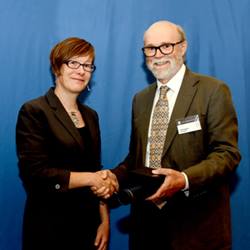 We bestow the medal named for Sir Roderick Impey Murchison on Professor Marian Holness of the University of Cambridge.
We bestow the medal named for Sir Roderick Impey Murchison on Professor Marian Holness of the University of Cambridge.
Marian is one of the most outstanding petrologists of her generation. Initially a metamorphic petrologist, Marian has made an extremely successful move to studying magmatic systems. Her research is founded in fundamental field observations, observational petrology, laboratory experiments and theory. She focuses on understanding the processes that occur during the melting and solidification of rocks, encompassing problems relevant to the formation of migmatites and the physical behaviour of gabbroic and granitic magmas trapped in the crust.
While most researchers working on magmatic intrusions use qualitative observations coupled with mineral geochemistry or theoretical modelling, Marian has pioneered a whole new quantitative approach based on her interpretations of microstructures. Indeed, Marian’s strength lies in recognising the importance of previously overlooked features and developing a quantitative understanding of what controls their development.
She has championed the application of Universal Stage Microscopy to obtain the 3D information to understand the complex textures of igneous and metamorphic rocks. With this knowledge she reconstructs how fluids and melts migrate within the Earth’s crust. By developing the use of grain geometry as a proxy for cooling rates, Marian has shown that cumulates record the step-wise changes in cooling rate predicted for fractionating systems and used this information to constrain the thickness of the mushy layer at the margins of magma chambers. She has also shown how microstructures record evidence of the fluid dynamics of magma, crucial in controlling its composition and eruptive behaviour.
Her work has taken her to diverse and sometimes difficult terrains, including the Scottish islands, Madagascar, South Africa and the iconic Skaergaard intrusion in Greenland.
Marian’s success led to her being elected as the EGU Division President for Geochemistry, Mineralogy, Petrology and Volcanology. She is also the Perspectives Editor for the Journal of Petrology.
Marian Holness, your research is highly original and has opened up much-needed new approaches for the study of magma chamber processes. You are a very worthy recipient of the Murchison Medal of The Geological Society and it is my great pleasure to present it to you now.
Marian Holness replied:
I cannot tell you how delighted and honoured I am to receive the Murchison Medal, and many thanks indeed for all the kind words about my science.
Despite my heartfelt gratitude, I very nearly didn’t come today. Since my husband was diagnosed with terminal lung cancer a few months ago, I’ve been unable to think much about work, or about anything really. But he was absolutely insistent that I should be here, so this is my first foray back into the outside world since our lives were turned upside down.
The pleasure of being awarded this medal is greatly enhanced by its long and distinguished history, with the list of previous recipients including my Cambridge heroes, Alfred Harker and Gertie Elles. In that context, I note that last year’s medalist, Janne Blichert-Toft, was the first woman to be awarded it since Ethel Shakespear in 1920. Very much like buses, you wait a century and then two come along at once.
Science is almost always a collaborative activity. Roderick Murchison himself provides an excellent example of that. He was mostly interested in fox-hunting until he got married, and it was his wife Charlotte, an accomplished geologist, who convinced him to apply his mind to geology. She made significant contributions to his work throughout his career, primarily scientific but also, towards the end of his life, by ameliorating the effects of his limited social skills.
My work is no exception and I have relied on many people over the years; students, post-docs and colleagues, to whom I am enormously grateful. But the one person who has been of overwhelming importance is my husband Stephen. As a mathematician he is unable to provide the direct input that Charlotte could provide Murchison, but he looked after the children while I was away at conferences or on fieldwork, carried rocks (and children) in the field, acted as a sounding board for outlandish ideas, cooked countless dinners, ameliorated the effects of my limited social skills, and was always there to pick up the pieces when things all got a Bit Too Much. This sort of support, expected and taken for granted by most male geologists in the past, but actually an immense privilege, has underpinned my career so far: I truly could not have done without it.
I very much wanted him to be here today, so I could thank him publicly in person, but he is too unwell to leave home. But here’s a heartfelt thank you to Stephen, a thank you to my wonderful collaborators and friends in Cambridge and elsewhere, and a thank you to the Geological Society for this recognition.
Professor Nicholas Kusznir (Lyell Medal)
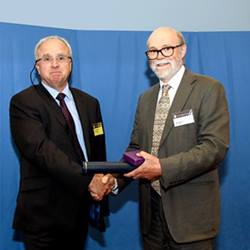 The Lyell Medal, named in honour of one of the 19th Century's most influential geologists, this year goes to Professor Nicholas Kusznir of the University of Liverpool.
The Lyell Medal, named in honour of one of the 19th Century's most influential geologists, this year goes to Professor Nicholas Kusznir of the University of Liverpool.
Nick’s work using satellite gravity and seismic reflection data has revolutionised our understanding of rift basin geodynamics, rifted continental margins and continental breakup—the least understood part of the Wilson Cycle.
Rift basins and rifted continental margins mark the juvenile stages of continental breakup and the initiation of ocean basin formation via seafloor spreading. Nick’s work has been instrumental in elucidating the structure, composition and location of the continent-ocean-transition, and the global mapping of rifted continental margins.
Nick has supervised over 60 PhD students and, over the past decade, led several highly successful industry-academic consortia projects that have sought to understand continental breakup processes.
Rifted basins and margins are not only an integral part of the plate tectonic cycle; these margins also host hydrocarbon deposits, so are critically important for the petroleum industry. In his research, Nick adapted the classic “McKenzie-model” of rift basin formation so that it could be used to investigate structural and stratigraphic problems on the scale of hydrocarbon traps.
The petroleum industry quickly picked up on this work. By applying his ideas to the geodynamics of the North Sea, other North Atlantic rift basins and then worldwide, Nick has rapidly become a global leading authority on the structure and composition of rifted margins and deep-water basins. In collaboration with colleagues at Badley Geoscience, Nick has worked on over 80 deep-water frontier exploration projects for the oil-and-gas industry and for national governments.
Nick Kusznir, your uniquely innovative approach blends insights from geophysics, geology and numerical modelling to develop strikingly original descriptions of the structure and formation of rift basins and rifted continental margins. You brought academically validated, cutting-edge research into the petroleum industry, where it has been incorporated into global exploration practices. It is my great pleasure to award you the Lyell Medal of The Geological Society of London.
Nick Kusznir replied:
Thank you, Mr President, for your kind words. I am delighted to receive the Lyell Medal and I am honoured that it carries the name of such a great geologist.
My first degree was in physics and I very nearly followed that with a PhD in elementary particle physics. Fortunately, for me, the final year of the Durham University physics degree had a small module in geophysics. This enticed me instead to take a PhD in geophysics under the supervision of Professor Martin Bott who was a wonderful supervisor and inspiration. I have had no regrets about that decision.
As well as having an excellent PhD supervisor, I would also like to thank my research collaborators. In particular, I would like to thank and acknowledge Graham Park, Alan Roberts, Gianreto Manatschal and Garry Karner who have attempted, with I hope some success, to teach geology to a physicist. I must also thank my PhD students. I am convinced that the PhD supervisor learns as much, if not more, from their PhD students than vice versa. I am also extremely grateful to my wife, Jean, for the support and understanding that she has given me throughout my career—not least for the occasional corrective nudge regarding work-life balance.
From my PhD onwards, my research aims have been to understand lithosphere deformation processes and the resulting response at the Earth’s surface. In my early career, I used numerical modelling to investigate lithosphere thermo-rheological behaviour. One way of testing these model predictions was to look at the resulting vertical motions of the Earth’s surface. This led to an appreciation of the value of stratigraphy and sedimentology as a palaeo-geodetic recorder of the Earth’s vertical motions. Sedimentary basins and rifted continental margins have provided an invaluable natural laboratory for investigating lithosphere deformation and global tectonics. This research, by me and many others, while motivated by pure science has found application in the search for natural resources. The resulting collaborations with industry have been invaluable for identifying many new scientific questions and the opportunity to answer them with data.
The enormous advances in our understanding of sedimentary basin and rifted margin formation processes have been achieved by global multidisciplinary collaboration. It has been exciting. The UK has punched above it weight in contributing to these advances. Some important names to mention for their contributions are Bob Whitmarsh, Tim Reston, Bob White, Nicky White and Dan McKenzie.
Charles Lyell is well known for his succinct summary of uniformitarianism: “The Present is the Key to the Past”. In reading about the evolution of this concept, I learnt that Lyell, following Hutton and Hume, also recognised that observations of past and present geological processes can be used to predict future geological events. This concept, which underpins much of science, not only geology, is clearly as important today as it was 200 or more years ago, when first proposed.
Mr. President, thank you once again for your kind words and the award of the Lyell Medal.
Professor Edward Stolper (Wollaston Medal)
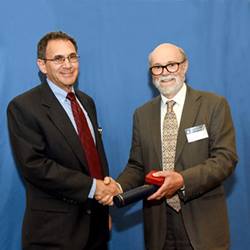 Finally, we come to the Wollaston Medal — the Society's senior medal and highest accolade, first awarded to William Smith in 1831. Today this award goes to Professor Edward Stolper of the California Institute of Technology (Caltech).
Finally, we come to the Wollaston Medal — the Society's senior medal and highest accolade, first awarded to William Smith in 1831. Today this award goes to Professor Edward Stolper of the California Institute of Technology (Caltech).
As an undergraduate, Ed studied geology at Harvard University. He moved to the University of Edinburgh for a master’s degree, before returning to Harvard to complete his PhD in 1979. That same year, Ed joined the Caltech faculty, and he has been there ever since, serving in various roles, including provost and interim president.
A world-leading igneous petrologist, Ed has an eclectic approach to his research. Using a combination of field observations, laboratory experiments, computer simulations, and theoretical considerations, he has unravelled the evolution of igneous rocks from across the solar system, including from Earth, Mars, the Moon, and asteroids.
Ed has achieved numerous firsts during his career. For example, he was first to propose that some igneous meteorites come from Mars. He developed the widely used ‘sandwich method’, a technique that enables quantification of melting of planetary mantles. He also developed infrared techniques to measure H2O and CO2 concentrations and speciation in glasses and melts and thermodynamic models of their behavior, and he was the first to demonstrate a linear relationship between the extent of melting and source water contents in back-arc environments. Ed was also the first to propose and then verify using shockwave techniques that magmas can become so dense with increasing pressure that deep in the mantle they can sink rather than rise buoyantly, with important implications for understanding the differentiation of large silicate planets.
Ed also co-led the Hawaiian Drilling Project, which cored over 3 km into the Mauna Kea volcano and was project scientist for the Curiosity rover (still exploring Mars’s surface today).
Through these and other studies, Ed and his colleagues have published countless classic papers that underpin our understanding of how igneous rocks form, and ultimately how the planets evolved.
Over the years, Ed’s achievements have been recognized with awards including the European Geoscience Union’s Holmes Medal, the Geological Society of America’s Day Medal, the Geochemical Society’s Clarke and Goldschmidt medals, and the Mineralogical Society of America’s Roebling Medal.
So, here we are, better late than never! Ed Stolper, in acknowledgment of your outstanding contributions to our subject, please accept the Wollaston Medal of the Geological Society of London.
Ed Stolper replied:
Thank you, Nick, for your very kind and generous citation. I was surprised and deeply humbled when I learned that I had been chosen for this recognition: Who among us would have the chutzpah to aspire to be on a list that includes the likes of Smith, Agassiz, Darwin, Dana, Lyell, Gilbert, Maskelyne (probably not known today to many, but the diagnostic phase of martian meteorites is “maskelynite”!), Day, Daly, Bowen, Holmes, and on and on. Moreover, it is the oldest geological award given by the oldest geological society in the English-speaking world, which would give anyone pause.
I also especially appreciate recognition by the UK geological community because of the role it played in my professional development. In 1974, I received something called a Marshall Scholarship, which supports American college graduates to come to the UK for post-graduate studies and was established by the British government in 1952 to thank the United States for the Marshall Plan. I spent two years at Edinburgh working with Mike O’Hara, and it was the second of the three most formative experiences of my early career. Barely a day goes by without my thinking about or using something I learned at Edinburgh, and the work done there launched my career. Moreover, the Marshall Scholarship also supported my wife, Lauren, during our time in Edinburgh (quite an enlightened attitude), so the experience was also a critical part of our early married life together.
I mentioned that my time in Edinburgh was the second of three defining experiences of my early career. The first was my participation at Harvard in the “freshman seminars” program, which is still in existence. These were courses available in your first year of college that allowed you to study a topic in detail in close contact with a professor. You had to apply to participate, and only a few students could be accommodated.
I applied for two seminars, one in astronomy and one in Earth science on lunar geology. Well, I was rejected by the astronomers, but accepted into the one on lunar geology. This seminar, led by Jim Hays, an experimental petrologist, and Charlie Burnham, a mineralogist/crystallographer, was a remarkable experience and the key inspiration for me to become a geologist. The Apollo 11 landing was in July 1969—50 years ago next month—and in the summer of 1970, when I was applying to the freshman seminar program, Science magazine had just published a special issue on the results of the preliminary investigations of the returned lunar samples. What we did in the seminar was to read and discuss all the papers in the special issue of Science, cover to cover (and it was much fatter than a typical issue of Science). Imagine the excitement of being introduced to geology via this unique experience connected to one of the most important events in the history of science!
This subsequently led to my working as an undergraduate with Jim Hays, Dave Walker, Tim Grove, and John Longhi on experimental petrology of lunar basalts; to my work at Edinburgh on the experimental petrology of basaltic meteorites with Mike O’Hara; and finally to my PhD in meteorite petrology and the recognition that certain igneous meteorites come from Mars (under the supervision of Jim Hays, the same man who taught me in the freshman seminar). As an aside, I have always been grateful to the unknown astronomers who (wisely) rejected me for their freshman seminar!
Finally, I will describe the third of my most important early professional experiences. Nick mentioned that I have been at Caltech since receiving my Ph.D., and, next month will mark the completion of 40 years on its faculty. I owe more than I can express to Caltech as an institution, to its Division of Geological and Planetary Sciences, and to my many friends and colleagues there, including three previous Wollaston medallists, Jerry Wasserburg, Sam Epstein, and Peter Wyllie. I sometimes shudder—literally—to think what my life would have been like if I had been hired somewhere else (and although it is too long a story to tell here, my hiring at Caltech was anything but routine or a foregone conclusion).
Thank you once again for this honour!